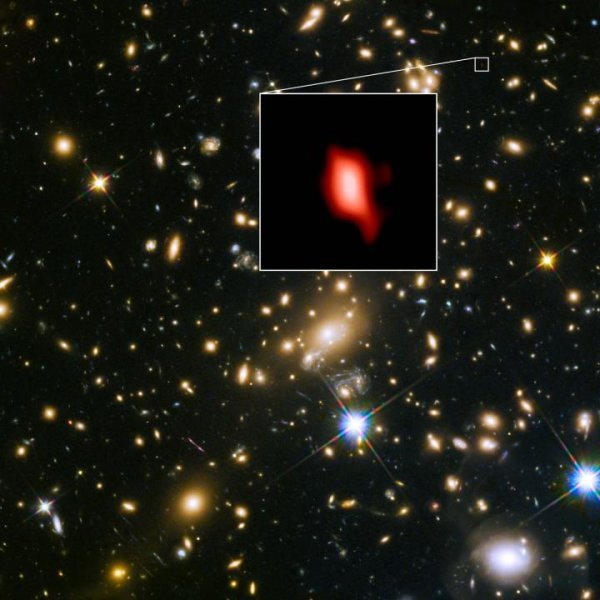Most distant oxygen ever detected in the universe.
An international team of astronomers used ALMA to observe a distant galaxy called MACS1149-JD1. They detected a very faint glow emitted by ionised oxygen in the galaxy. As this infrared light travelled across space, the expansion of the Universe stretched it to wavelengths more than ten times longer by the time it reached Earth and was detected by ALMA. The team inferred that the signal was emitted 13.3 billion years ago (or 500 million years after the Big Bang), making it the most distant oxygen ever detected by any telescope [1]. The presence of oxygen is a clear sign that there must have been even earlier generations of stars in this galaxy.
"I was thrilled to see the signal of the distant oxygen in the ALMA data," says Takuya Hashimoto, the lead author of the new paper and a researcher at both Osaka Sangyo University and the National Astronomical Observatory of Japan . "This detection pushes back the frontiers of the observable Universe."
In addition to the glow from oxygen picked up by ALMA, a weaker signal of hydrogen emission was also detected by ESO's Very Large Telescope (VLT). The distance to the galaxy determined from this observation is consistent with the distance from the oxygen observation. This makes MACS1149-JD1 the most distant galaxy with a precise distance measurement and the most distant galaxy ever observed with ALMA or the VLT.
"This galaxy is seen at a time when the Universe was only 500 million years old and yet it already has a population of mature stars," explains Nicolas Laporte, a researcher at University College London (UCL) in the UK and second author of the new paper. "We are therefore able to use this galaxy to probe into an earlier, completely uncharted period of cosmic history."
For a period after the Big Bang there was no oxygen in the Universe; it was created by the fusion processes of the first stars and then released when these stars died. The detection of oxygen in MACS1149-JD1 indicates that these earlier generations of stars had been already formed and expelled oxygen by just 500 million years after the beginning of the Universe.
But when did this earlier star formation occur? To find out, the team reconstructed the earlier history of MACS1149-JD1 using infrared data taken with the NASA/ESA Hubble Space Telescope and the NASA Spitzer Space Telescope. They found that the observed brightness of the galaxy is well-explained by a model where the onset of star formation corresponds to only 250 million years after the Universe began [2].
The maturity of the stars seen in MACS1149-JD1 raises the question of when the very first galaxies emerged from total darkness, an epoch astronomers romantically term "cosmic dawn." By establishing the age of MACS1149-JD1, the team has effectively demonstrated that galaxies existed earlier than those we can currently directly detect.
Richard Ellis, senior astronomer at UCL and co-author of the paper, concludes: "Determining when cosmic dawn occurred is akin to the Holy Grail of cosmology and galaxy formation. With these new observations of MACS1149-JD1 we are getting closer to directly witnessing the birth of starlight! Since we are all made of processed stellar material, this is really finding our own origins."
Notes
[1] ALMA has set the record for detecting the most distant oxygen several times. In 2016, Akio Inoue at Osaka Sangyo University and his colleagues used ALMA to find a signal of oxygen emitted 13.1 billion years ago. Several months later, Nicolas Laporte of University College London used ALMA to detect oxygen 13.2 billion years ago. Now, the two teams combined their efforts and achieved this new record, which corresponds to a redshift of 9.1.
[2] This corresponds to a redshift of about 15.
More information
These results are published in a paper entitled: "The onset of star formation 250 million years after the Big Bang," by T. Hashimoto et al., to appear in the journal Nature on 17 May 2018.
The research team members are: Takuya Hashimoto (Osaka Sangyo University/National Astronomical Observatory of Japan, Japan), Nicolas Laporte (University College London, United Kingdom), Ken Mawatari (Osaka Sangyo University, Japan), Richard S. Ellis (University College London, United Kingdom), Akio. K. Inoue (Osaka Sangyo University, Japan), Erik Zackrisson (Uppsala University, Sweden), Guido Roberts-Borsani (University College London, United Kingdom), Wei Zheng (Johns Hopkins University, Baltimore, Maryland, United States), Yoichi Tamura (Nagoya University, Japan), Franz E. Bauer (Pontificia Universidad Católica de Chile, Santiago, Chile), Thomas Fletcher (University College London, United Kingdom), Yuichi Harikane (The University of Tokyo, Japan), Bunyo Hatsukade (The University of Tokyo, Japan), Natsuki H. Hayatsu (The University of Tokyo, Japan; ESO, Garching, Germany), Yuichi Matsuda (National Astronomical Observatory of Japan/SOKENDAI, Japan), Hiroshi Matsuo (National Astronomical Observatory of Japan/SOKENDAI, Japan, Sapporo, Japan), Takashi Okamoto (Hokkaido University, Sapporo, Japan), Masami Ouchi (The University of Tokyo, Japan), Roser Pelló (Université de Toulouse, France), Claes-Erik Rydberg (Universität Heidelberg, Germany), Ikkoh Shimizu (Osaka University, Japan), Yoshiaki Taniguchi (The Open University of Japan, Chiba, Japan), Hideki Umehata (The University of Tokyo, Japan) and Naoki Yoshida (The University of Tokyo, Japan).
Hi! I am a robot. I just upvoted you! I found similar content that readers might be interested in:
https://www.sciencedaily.com/releases/2018/05/180516131214.htm